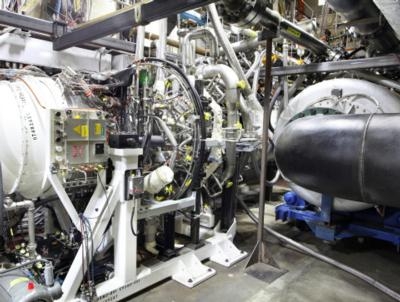Mon, Oct 15, 2012
ADVENT Program In Conjunction With The U.S. Air Force Research Laboratory
Engine core testing for the ADaptive Versatile ENgine Technology (ADVENT) program with the U.S. Air Force Research Laboratory is underway at GE Aviation’s headquarters in Evendale, Ohio. The core test demonstrates GE’s most advanced core propulsion technologies including lightweight, heat-resistant ceramic matrix composite (CMC) materials. These core technologies, along with an adaptive low pressure spool, will result in a 25 percent improvement in fuel efficiency, a 30 percent increase in operating range and a five-to-ten percent improvement in thrust compared to today’s fixed-cycle engines.

The ADVENT program is scheduled to conclude in 2013 with a full engine test. GE will continue to mature the ADVENT technologies through the Air Force’s Adaptive Engine Technology Development (AETD) program, which will conclude in 2016 following fan rig testing and a core engine test.
“The ADVENT engine is a revolutionary military engine,” said Jeff Martin, GE Aviation’s general manager for the ADVENT program. “Packaged together, GE’s variable-pressure-ratio fan, CMC materials and high-pressure-ratio core technologies will enable the Air Force to meet the aggressive performance targets required for future missions.”
“GE Aviation is honored to partner with the Air Force in the demonstration of these unique technologies,” said Dan McCormick, GE Aviation’s general manager for the AETD program. “Along with advanced controls and exhaust system designs, we will integrate proven ADVENT technologies like third-stream cooling and CMCs into our AETD engine.”
Unlike fixed cycle engine architectures powering today’s aircraft, variable cycle architectures are designed to operate efficiently in conditions across the entire flight envelope, including subsonic and supersonic speeds. GE’s adaptive cycle design includes a third stream of air that can be utilized for maximum fuel efficiency while providing thermal management advantages to a conventional engine.

The ADVENT engine is GE Aviation’s most recent development program to successfully demonstrate the variable cycle architecture. Following initial studies by Gerhard Neumann in the 1960s, GE’s YJ101 was the first full engine to demonstrate variable cycle capabilities in 1976. GE built on the YJ101 experience to produce the YF120 variable cycle engine for the Advanced Tactical Fighter project, which set the world supercruise record in 1990.
The ADVENT and AETD variable cycle engines are improving on the YF120 design while integrating technologies developed through GE Aviation’s $600 million investment in commercial engine programs, such as high pressure compressors and lightweight CMCs in the high- and low-pressure turbines that result in reduced engine weight and minimize the need for cooling. The ADVENT engine will be GE’s highest overall pressure ratio military engine, resulting in a significant fuel consumption improvement compared to today’s engines.
(Images provided by GE Aviation)
More News
Also: SkyReach Parts Support, Piper Service Ctr, Airliner Near-Miss, Airshow London The Judge overseeing Icon's convoluted Chapter 11 process has approved $9 million in Chapter 11 >[...]
ILS PRM Approach An instrument landing system (ILS) approach conducted to parallel runways whose extended centerlines are separated by less than 4,300 feet and at least 3,000 feet >[...]
Aero Linx: FlyPups FlyPups transports dogs from desperate situations to fosters, no-kill shelters, and fur-ever homes. We deliver trained dogs to veterans for service and companion>[...]
Also: Skydio Chief, Uncle Sam Sues, Dash 7 magniX, OR UAS Accelerator US Secretary of the Air Force Frank Kendall was given a turn around the patch in the 'X-62A Variable In-flight>[...]
Also: NBAA on FAA Reauth, DJI AG Drones, HI Insurance Bill Defeated, SPSA Airtankers The Beechcraft Denali continues moving forward towards certification, having received its FAA T>[...]
 Airborne 05.10.24: Icon Auction, Drunk MedEvac Pilot, Bell ALFA
Airborne 05.10.24: Icon Auction, Drunk MedEvac Pilot, Bell ALFA ANN's Daily Aero-Term (05.13.24): ILS PRM Approach
ANN's Daily Aero-Term (05.13.24): ILS PRM Approach ANN's Daily Aero-Linx (05.13.24)
ANN's Daily Aero-Linx (05.13.24) Airborne-NextGen 05.07.24: AI-Piloted F-16, AgEagle, 1st 2 WorldView Sats
Airborne-NextGen 05.07.24: AI-Piloted F-16, AgEagle, 1st 2 WorldView Sats Airborne 05.08.24: Denali Update, Dad-Daughter Gyro, Lake SAIB
Airborne 05.08.24: Denali Update, Dad-Daughter Gyro, Lake SAIB




